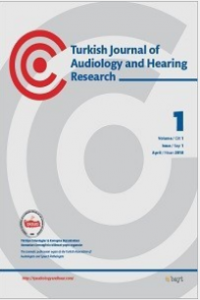Genç Yetişkinlerde Video Head İmpulse Test Normalizasyonu
Özet
Amaç: Video Head Impulse Test(v-HIT), uygulanması kolay, objektif, altı semisirküler kanalın (SSK) değerlendirilmesine ve vestibülo-oküler refleks (VOR) sırasında meydana gelen gizli sakkadların görülmesine olanak sağlayan bir testtir. Çalışmanın amacı, 18-30 yaş arasındaki sağlıklı bireylerden elde edilen v-HIT verileri ile VOR kazancı normatif verilerinin oluşturularak cinsiyete bağlı ve olarak ve tüm bireylerde karşılaştırmalar yapmaktır.
Metod: Çalışmaya 18-30 yaş arası 130 Türk sağlıklı birey (65K- 65E) dahil edilmiştir Bireylere SYNAPSIS Vhıt Ulmer marka cihaz ile v-HIT uygulanmıştır. Bireyler 90 cm uzaklıktaki nesneye bakarken horizontal kanalları uyarabilmek için 30 derece öne doğru fleksiyon açıyla, vertikal kanalları test etmek için, baş sağa ve sola 30-45 derece açıyla çevrilmiştir. Her kanalda 5 uyarım alınmıştır. Test güvenilirliği için tüm bireylere yarım saat sonra yeniden test yapılmıştır. Bireylerin VOR kazançları tüm kanallarda cinsiyete göre ve tüm bireylerde karşılaştırılmıştır.
Sonuçlar: Tüm bireylerin v-HIT sonuçları değerlendirildiğinde sağ-sol kulak anterior ve posterior kanallarda istatistiksel olarak anlamlı fark elde edilmiştir (p<0.05). Cinsiyete göre v-HIT sonuçları değerlendirildiğinde kadınlarda sağ anterior kanalda istatistiksel olarak anlamlı farklılık elde edilmiştir (p<0.05).Test yeniden test sonuçları değerlendirildiğinde tüm kanallarda pozitif yönlü, yüksek düzeyde ve istatistiksel olarak anlamlı bir ilişki elde edilmiştir.
Öneriler: Çalışmamız, 18-30 yaş aralığında en fazla bireyle yapılan çalışma olması ve kadın erkek sayılarının tüm yaş gruplarında eşit dağılımının sağlanması ile benzer çalışmalardan ayrılmaktadır. Çalışmamızın güvenilirlik korelasyonun yüksek olması normatif değerlerin diğer kliniklerde referans olarak kullanılabileceği ve bu değerlerin hastalıklarla yapılan çalışmalarda da kontrol grubu olarak kullanılabileceğini düşündürmektedir.
Anahtar Kelimeler:
normalizasyon, vor, vestibüler sistem, video head impulse test, yakalama sakkadı
Video Head Impulse Test Normalization in Young Adults
Summary
Objective: The Video Head Impulse Test (v-HIT) is an easy-to-use, objective test that allows the evaluation of the six semicircular canals (CSC) and the visualization of the hidden saccades that occur during the vestibulo-ocular reflex (VOR). The aim of the study is to compare v-HIT data obtained from healthy individuals between the ages of 18-30 and VOR normative data based on gender and in all individuals.
Method: 130 Turkish healthy individuals (65F-65E) aged 18-30 years were included in the study. V-HIT was applied to the individuals with a SYNAPSIS Vhit Ulmer device. While looking at an object 90 cm away, individuals were turned to 30 degrees of forward flexion to stimulate the horizontal canals, and to test the vertical canals, the head was turned to the right and left at an angle of 30-45 degrees. 5 stimulations were received in each channel. For test reliability, all individuals were retested half an hour later. Individuals' VOR gains were compared by gender across all channels and across all individuals.
Results: When the v-HIT results of all individuals were evaluated, a statistical difference was obtained in the anterior and posterior canals of the right-left ear (p<0.05). When v-HIT results were evaluated according to gender, a statistical difference was obtained in the right anterior canal in women (p<0.05). When the test-retest results were evaluated, a positive, high-level and statistically significant relationship was obtained in all channels.
Conclusions: : Our study differs from similar studies in that it is structured with the highest number of people between the ages of 18-30 and that the number of men and women is equally distributed in all age groups. The high general structure of our study suggests that normative values can be used as a reference in other clinics and that the settings made with tissues of these values can be used as a control group.
Keywords:
vor, video head impulse test, vestibular system, normalization, catch-up saccad,
___
- Khan, S., & Chang, R. (2013). Anatomy of the vestibular system: a review. NeuroRehabilitation, 32(3), 437–43. [CrossRef]
- Baloh, R. W., Honrubia, V., & Kerber, K. A. (2010). Baloh and Honrubia’s Clinical Neurophysiology of the Vestibular System, 4th Ed. Oxford University Press.
- Welgampola, M. S., Bradshaw, A. P., & Halmagyi, G. M. (2019). Assessment of the vestibular system: history and physical examination. Adv Otorhinolaryngol, 82, 1–11.
- Nandi, R., & Luxon, L. M. (2008). Development and assessment of the vestibular system. Int J Audiol, 47(9), 566–577. https://doi.org/10.1080/14992020802324540
- Alhabib, S. F., & Saliba, I. (2017). Video head impulse test: a review of the literature. Eur Arch Otorhinolaryngol,274(3), 1215–1222. [CrossRef]
- Kheradmand, A., & Zee, D. S. (2012). The bedside examination of the vestibulo-ocular reflex (VOR): an update. Rev Neurol (Paris), 168(10), 710–719. [CrossRef]
- MacDougall, H. G., McGarvie, L. A., Halmagyi, G. M., Curthoys, I. S., & Weber, K. P. (2013). Application of the video head impulse test to detect vertical semicircular canal dysfunction. Otol Neurotol, 34(6), 974–979. [CrossRef]
- MacDougall, H. G., McGarvie, L. A., Halmagyi, G. M., Rogers, S. J., Manzari, L., Burgess, A. M., …, Weber, K. P. (2016). A new saccadic indicator of peripheral vestibular function based on the video head impulse test. Neurology, 87(4), 410–418. [CrossRef]
- ISSN: 2651-3757
- Başlangıç: 2018
- Yayıncı: Odyoloji Konuşma ve Ses Bozuklukları Derneği
Sayıdaki Diğer Makaleler
Memduha TAŞ, Murat ARSLAN, Gülçin HANÇER ARSLAN, Emre ATILGAN, Yurdagül Melek ERKİRAZ, Şöhret ABAY, Elif ERYILMAZ, Şüle YILMAZ, Nagehan GÜMÜŞEL BULUT, Ömer DEVELİOĞLU, Erdogan BULUT
VESTİBÜLER FONKSİYONLARI ETKİLEYEN DORSOLATERAL MEDÜLLER İSKEMİK İNFARKT: OLGU SUNUMU
Halil Berkay SALDIRIM, Emre GÜRLEK, Ayberk Aydın TUNÇ, Mustafa Bülent ŞERBETÇİOĞLU
Berfin Eylül AYDEMİR, Çağla DİKDERİ, Asuman ALNIAÇIK, Eda ÇAKMAK
Genç Yetişkinlerde Video Head İmpulse Test Normalizasyonu
Beyza DEMİRTAŞ, Öznur YİĞİT, Görkem ERTUĞRUL, Gülsüm GENÇ
Eyyüp Diyar DOĞAN, Mustafa Bülent ŞERBETÇİOĞLU
Samet KILIÇ, Irem ADALİLAR, Halime Sümeyra SEVMEZ, Eser SENDESEN, Murat ŞAHİN, Hilal DİNÇER D'ALESSANDRO, Didem TÜRKYILMAZ
